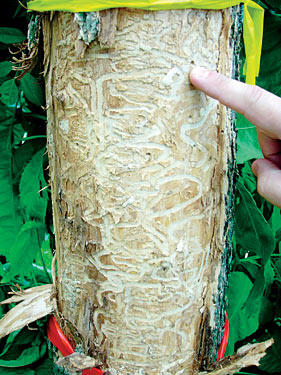http://en.wikipedia.org/wiki/Emerald_Ash_Borer wrote:

A green ash killed by emerald ash borers
<<The emerald ash borer (Agrilus planipennis or Agrilus marcopoli and EAB) is a green beetle native to Asia. In North America the borer is an invasive species, highly destructive to ash trees in its introduced range. The potential damage of this insect rivals that of Chestnut blight and Dutch Elm Disease. Since its accidental introduction into the United States and Canada in the 1990s, and its subsequent detection in 2002, it has spread to 14 states and adjacent parts of Canada. It has killed at least 50 to 100 million ash trees so far and threatens to kill most of the 7.5 billion ash trees throughout North America. The emerald ash borer is now one of the most destructive non-native insects in the United States; it and other wood-boring pests cause an estimated $3.5 billion in annual damages in the U.S.
The insect threatens the entire North American Fraxinus genus, unlike past invasive tree pests, which have only threatened a single species within a genus. The green ash and the black ash trees are preferred. White ash is also killed rapidly, but usually only after green and black ash trees are eliminated. Blue ash displays some resistance to the emerald ash borer by forming callous tissue around EAB galleries; however, they are usually killed eventually as well.
The adult beetle is dark metallic green, bullet-shaped and about 8.5 millimetres long and 1.6 mm wide. The body is narrow and elongated, and the head is flat with black eyes. Adults lay eggs in crevasses in the bark. Larvae burrow into the bark after hatching and consume the cambium and phloem, effectively girdling the tree and causing death within two years. The average emerging season for the emerald ash borer is early spring to late summer. Females lay around 75 eggs, but up to 300 from early May to mid-July. The borer's life cycle is estimated to be one year in southern Michigan but may be up to two years in colder regions.
The natural range of the emerald ash borer is eastern Russia, northern China, Japan, and Korea. Its first confirmed North American detection was in June 2002 in Canton, Michigan. It is suspected, that it was introduced by overseas shipping containers being delivered to Yazaki North America. It has since been found in several other parts of the United States and Canada. Ohio, Minnesota, and Ontario have experienced emerald ash borer migration from Michigan. Additionally, Maryland and Virginia received shipments of contaminated trees from a Michigan nursery. The emerald ash borer was confirmed in Indiana in April 2004, in Central Kentucky in the Spring of 2009 and in Northeast Iowa in May 2010.
The insect is unusually difficult to kill. More than 7.5 billion ash trees are currently at risk. Nearly 114 million board feet of ash saw timber with a value of US$25.1 billion is grown in the eastern United States each year. Over forty million ash trees have died or are dying in the United States at this time. The full time it takes for a tree to die due to the EAB is generally two or three years. Losses are estimated in the tens of millions of dollars. The National Ash Seed Collection Initiative collects and stores ash seeds in cryogenic vaults at the National Center for Genetic Resources Preservation in Fort Collins, CO. If the population of American ash trees is destroyed, the stored seeds will be the genetic base to re-establish ash.
As part of the campaign against the emerald ash borer (EAB), American scientists in conjunction with the Chinese Academy of Forestry searched since 2003 for its natural enemies in the wild leading to the discovery of several parasitoid wasps including Tetrastichus planipennisi. These tiny stingless wasps can sense beetles underneath the bark and then lay their eggs in the larvae or egg, thus killing them. Initial results have shown promise and it is now being released along with Beauveria bassiana, a fungal pathogen with known insecticidal properties.>>




